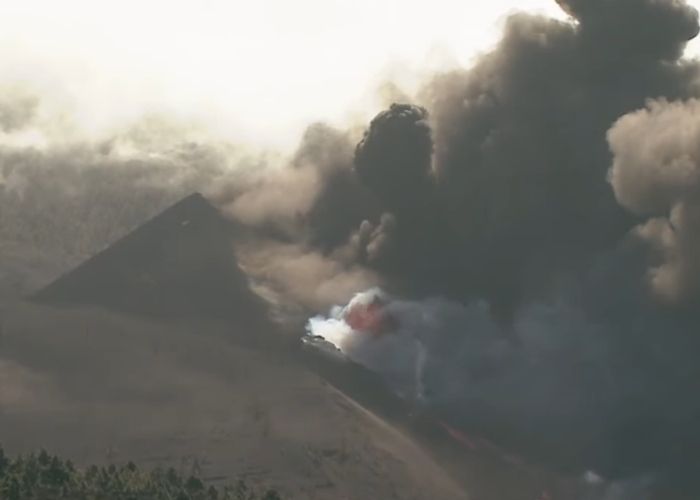LA PALMA – Lava from the Cumbre Vieja volcano on La Palma reached the ocean off the coast of the municipality of Tazacorte around the area known as Playa de los Guirres (also known as Playa Nueva) around 11 pm on Tuesday night (Canary Island time, an hour later in mainland Spain).
Overall, according to the US Geological Survey, there are four main hazards associated with lava flowing into the ocean.
- the sudden collapse of coastal land and cliffs
- explosions caused by this collapse
- waves of boiling water generated in the area
- the plume of toxic smoke containing hydrochloric acid and small particles of volcanic crystals.
Areas deposited
On La Palma, the lava – with a temperature of over 1,000 degrees – flowed through a 100-metre-high cliff into the sea. The toxic clouds are the authorities’ main concern. Therefore, the situation led to the emergency closure of four villages at midnight. This was due to the danger of toxic gas emissions. An area in the ocean was also cordoned off.
The black smoke comes ashore due to the onshore wind blowing from the water at night. A group of marine geoscientists from the Spanish Institute of Oceanography is monitoring the lava’s advance. They said that ‘an impressive deposit of over 50 metres in height’ had formed in less than 45 minutes. Futhermore, it was continuing to grow. It is like a pyramid growing out of the sea.
Last obstacle before the ocean
Shortly before 10.00 pm on Tuesday, the Instituto Vulcanológico de Canarias reported the lava flow crossed the so-called coastal road. This is located next to the 320-metre-high Montaña de Todoque, in the municipality of Tazacorte. It was the last obstacle before the lava flow would reach the coast. The distance between the road and the coast is about one kilometre. After reaching the Montaña de Todoque, the lava flow accelerated due to the steepness of the terrain. Countless banana plantations, which thrive on the fertile soil in the area, have been devoured.
Live footage from the Guardia Civil
Concerns about possible toxic clouds
The flow of lava into the ocean and the resulting toxic clouds have worried the authorities since the beginning. Consequently, extra measures have been taken to protect residents; the only person officially recorded as having been killed by the Teneguía volcano in 1971 died as a result of inhaling these toxic gases.
Hawaii or Stromboli
The director of the National Geographic Institute (IGN) in the Canary Islands, María José Blanco, reported on Tuesday that the phenomena from one of the volcano’s mouths, in the northern part, have changed somewhat ‘in the direction of Hawaiian behaviour’. In this type of eruption, the process is usually calmer because the lava is more fluid. Futhermore, the gases are easily released and there are no explosions.
So far, the authorities have stated in no uncertain terms that it was a ‘fissure, an eruption of Strombolian nature’, in other words, it was said to be an opening of a fissure in the mountain that is permanent, of liquid lava and studded with explosive eruptions.
The course
The emission of lava, smoke and ash stopped for two hours on Monday morning but resumed at 10.30 am. This is usual for this type of eruption. On Monday afternoon, the lava had slowed down due to the mountainous landscape of the island of La Palma. As a result, the scientific committee of the Special Plan for Civil Protection and emergency workers doubted whether the lava would eventually reach the sea.
Seabed can recover quickly
Not everything goes down when the sea encounters a volcano, as the recent underwater eruption on El Hierro in 2011 showed. The oceanographic research vessel Ramón Margalef arrived on Saturday to study in detail the arrival of the lava in the sea, and is also examining the rocks and corals in the area.
‘These organisms absorb sulphur and other gases spewed out by the volcano, so the Margalef also hopes to study the impact that the massive influx of lava will have on the fauna,’ explained researcher at the Spanish Institute of Oceanography, Eugenio Fraile. The organisms most affected will be those that are attached to the sea floor and cannot move, they will probably die. But recovery can be rapid.
Three years after the eruption of the underwater volcano on El Hierro, these organisms had almost completely renewed themselves,’ Fraile continued. The ship will also map the seabed after the eruption and will be able to compare this bathymetric map -which shows the different depths of the seabed through depth lines- with the map it made in 2018, when La Palma was already rocked by a swarm of earthquakes.
Possible consequences
One possibility is that the sea will turn turquoise green and form a huge stain that can be seen from space. This is what happened in Hawaii in 2018. The lava flow displaced the shallower water layers so that the deeper layers, which contain much more nutrients, rose up and promoted the growth of algae that coloured the water.
The new volcano could also feed on a deeper lava reservoir. This happened, for example, with the undersea volcano of El Hierro,
Difficult to estimate
At present, there is no estimate on how long the volcano will continue to spew lava. The longest documented eruption on La Palma was that of Tehuya in 1586, which lasted 84 days. The shortest, on the other hand, was the last on the island, that of Teneguía, in 1971, which lasted 24 days.


